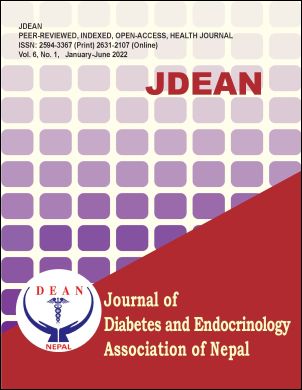Study of technetium pertechnetate (99mTcO4) thyroid scintigraphy imaging among patients presenting with thyrotoxicosis at a tertiary care hospital in Kathmandu, Nepal
DOI:
https://doi.org/10.3126/jdean.v6i1.50350Keywords:
Hyperthyroidism, Graves' disease, thyroiditis, Thyrotoxicosis, 99mTC04 ScanAbstract
Background: Thyroid disorders represent an important public health problem worldwide. Excess thyroid hormone in the circulation due to any cause is termed as thyrotoxicosis. There are many causes of thyrotoxicosis, and it is important to find the cause as this will determine the management of the condition. 99mTcO4scintigraphy is diagnostic tool to differentiate various causes of thyrotoxicosis. This study aims to study the age and gender distribution of different causes of thyrotoxicosis.
Methods: This is a retrospective analysis of technetium pertechnetate(99mTcO4) thyroid scintigraphy reports done of patients having thyrotoxicosis from the period of January 01, 2016, to December 31, 2016, at the Nuclear Medicine unit of National Academy of Medical Sciences, Bir Hospital, Kathmandu. Gender and age group analysis of the data was done using SPSS program.
Results: A total of 211 reports of 99m TcO 4 thyroid scintigraphy were included in the study. There were 61 male patients and 150 female patients. Various causes of thyrotoxicosis like thyroiditis, Graves’ disease, autonomous functioning thyroid nodule, toxic multinodular goiter was detected. Apart from toxic multinodular goiter, these disorders were more common in the age group 18-50 years and females.
Conclusion: 99mTcO4 thyroid scintigraphy is one of the easy and highly effective tools for the differential diagnosis of thyrotoxicosis. Both thyroiditis and Graves’ disease are more predominant in the age group 18-50 years and in females. Further large community-based studies will be required for exact prevalence of the diseases in the population.
Downloads
Downloads
Published
How to Cite
Issue
Section
License
Copyright (c) 2022 D. Malla, S. Maharjan, A. D. Rajouriya, B. B. Karki, P. S. Shrestha, C. Shrestha, D. Shrestha, M. R. Bajracharya

This work is licensed under a Creative Commons Attribution-NonCommercial 4.0 International License.
This license enables reusers to distribute, remix, adapt, and build upon the material in any medium or format for non-commercial purposes only, and only so long as attribution is given to the creator.




